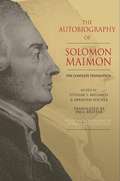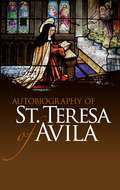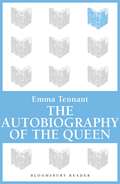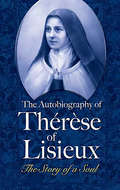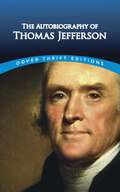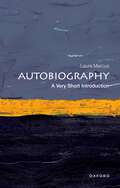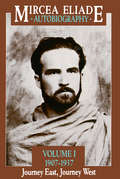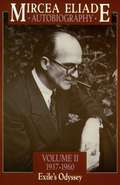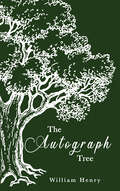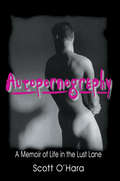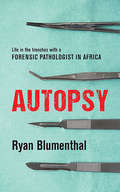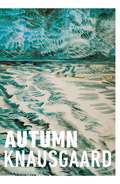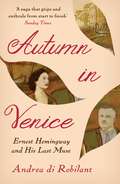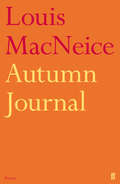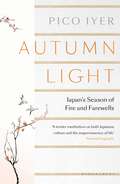- Table View
- List View
The Autobiography of Solomon Maimon: The Complete Translation
by Solomon Maimon Yitzhak Y. Melamed Abraham Socher Gideon FreudenthalThe first complete and annotated English translation of Maimon’s influential and delightfully entertaining memoirSolomon Maimon's autobiography has delighted readers for more than two hundred years, from Goethe, Schiller, and George Eliot to Walter Benjamin and Hannah Arendt. The American poet and critic Adam Kirsch has named it one of the most crucial Jewish books of modern times. Here is the first complete and annotated English edition of this enduring and lively work.Born into a down-on-its-luck provincial Jewish family in 1753, Maimon quickly distinguished himself as a prodigy in learning. Even as a young child, he chafed at the constraints of his Talmudic education and rabbinical training. He recounts how he sought stimulation in the Hasidic community and among students of the Kabbalah--and offers rare and often wickedly funny accounts of both. After a series of picaresque misadventures, Maimon reached Berlin, where he became part of the city's famed Jewish Enlightenment and achieved the philosophical education he so desperately wanted, winning acclaim for being the "sharpest" of Kant's critics, as Kant himself described him.This new edition restores text cut from the abridged 1888 translation by J. Clark Murray, which has long been the only available English edition. Paul Reitter's translation is brilliantly sensitive to the subtleties of Maimon's prose while providing a fluid rendering that contemporary readers will enjoy, and is accompanied by an introduction and notes by Yitzhak Melamed and Abraham Socher that give invaluable insights into Maimon and his extraordinary life. The book also features an afterword by Gideon Freudenthal that provides an authoritative overview of Maimon's contribution to modern philosophy.
Autobiography of St. Teresa of Avila
by St. Teresa of AvilaIn this landmark of Christian mysticism, the revered Carmelite nun presents moving accounts of her profound religious experiences and ultimate union with God. St. Teresa wrote this memoir at the behest of her confessor. It offers a warm, accessible account of her transformation into an impassioned leader and reformer of church doctrine.St. Teresa recounts her childhood and education in sixteenth-century Spain, her physical afflictions and spiritual crises, her many visions and mystical encounters, and her determination to embrace the contemplative life. In describing the ascent of the soul, she explains the core of her theology as a four-stage process that progresses from mental prayer to divine rapture. Next to Don Quixote, this timeless work constitutes Spain's most popular prose classic. It forms an excellent introduction to the saint's other writings and to the Christian tradition of mystical literature.
The Autobiography of the Queen
by Emma TennantThe Queen goes AWOL. No one can find her: where is she going and why ?In Emma Tennant's hilarious 'autobiography' of Queen Elizabeth, the monarch moves to the Caribbean island of St Lucia, where, after more than half a century on the throne, she can recall the years of her reign in peace and tranquillity.But the house is no more than a hole in the ground, her servants are gone and no one knows that 'Mrs Gloria Smith' is the Queen of England. The Queen quickly realizes she has a lot to learn about living life as a commoner.The story of the sovereign's new life in St Lucia is a funny and touching account of the friendship, sometimes contentious and on occasion baffling, between Her Majesty Queen Elizabeth and a young St Lucian, Austin Ford. How the Queen reacts to her new life- and how she changes as a result- make The Autobiography of the Queen a hilarious and moving tale, in which her need for her subjects is a marked as their dependence on her staying on the throne."A quiet, quirky charm" - The Times
The Autobiography of Thérèse of Lisieux: The Story of a Soul
by Thérèse Of Lisieux"Our Lord does not look so much at the greatness of our actions, nor even at their difficulty, but at the love with which we do them." -- Saint Thérèse of LisieuxOne of the greatest spiritual classics ever written, this influential autobiography has been translated into nearly every language, capturing hearts and minds around the world. Simply written in clear, enchanting prose, this memoir reveals the path to true inner peace, for "Our Lord needs from us neither great deeds nor profound thoughts. Neither intelligence nor talents. He cherishes simplicity."Born in France, young Thérèse Martin (1873-1897) entered the Carmel Convent of Lisieux at the age of fifteen. Also known as "the Little Flower," her autobiography, written at the request of her Carmelite Superiors in the last years of her life, includes poignant girlhood recollections and her teachings of "the little way of childhood." The "little way," inspired by the Gospel, places love at the very center of every action we take. Traditional yet unique, delicate yet heroic, Thérèse taught a shining spirituality that could easily be adapted into everyday life. Her divine words of acceptance and love are universal, and have gently led many people -- both within the Catholic Church and outside of Christianity -- back to their faith.Saint Thérèse was canonized by Pope Pius XI in 1925. In 1997, she was proclaimed a Doctor of the Church by Pope John Paul II.
The Autobiography of Thomas Jefferson
by Thomas JeffersonDuring his remarkable lifetime, Thomas Jefferson (1743–1826) served his country in many capacities, including as the third President of the United States. But ultimately, this gifted individual — an accomplished architect, naturalist, and linguist — wished to be remembered primarily as the writer of the Declaration of Independence.In this autobiography, begun in 1821 when the author was 77, Jefferson touches fleetingly upon his early years before focusing on the period during which he wrote the Declaration. This edition features a fascinating first draft of the document, in addition to Jefferson's comments on the Articles of Confederation. Other highlights include his firsthand observations on the early stages of the French Revolution, obtained while serving as Minister to France, as well as insights from his many other public roles: wartime Governor of Virginia, Washington's Secretary of State, and Vice President during the John Adams administration. This brief memoir provides a rare opportunity to share the reflections of a Founding Father as written in his own words.
An Autobiography or the Story of My Experiments with Truth
by Mahatma GandhiAlthough Gandhi presents his episodes chronologically, he leaves wide gaps, such as the entire satyagraha struggle in South Africa, for which he refers the reader to another of his books.
Autobiography: A Very Short Introduction (Very Short Introductions)
by Laura MarcusAutobiography is one of the most popular of written forms. From Casanova to Benjamin Franklin to the Kardashians, individuals throughout history have recorded their own lives and experiences. These personal writings are central to the work of literary critics, philosophers, historians and psychologists, who have found in autobiographies from across the centuries not only an understanding of the ways in which lives have been lived, but the most fundamental accounts of what it means to be a self in the world. In this Very Short Introduction Laura Marcus defines what we mean by 'autobiography', and considers its relationship with similar literary forms such as memoirs, journals, letters, diaries, and essays. Analysing the core themes in autobiographical writing, such as confession, conversion and testimony; romanticism and the journeying self; Marcus discusses the autobiographical consciousness (and the roles played by time, memory and identity), and considers the relationship between psychoanalysis and autobiography. Exploring the themes of self-portraiture and performance, Marcus also discusses the ways in which fiction and autobiography have shaped each other. ABOUT THE SERIES: The Very Short Introductions series from Oxford University Press contains hundreds of titles in almost every subject area. These pocket-sized books are the perfect way to get ahead in a new subject quickly. Our expert authors combine facts, analysis, perspective, new ideas, and enthusiasm to make interesting and challenging topics highly readable.
Autobiography: A Very Short Introduction (Very Short Introductions)
by Laura MarcusAutobiography is one of the most popular of written forms. From Casanova to Benjamin Franklin to the Kardashians, individuals throughout history have recorded their own lives and experiences. These personal writings are central to the work of literary critics, philosophers, historians and psychologists, who have found in autobiographies from across the centuries not only an understanding of the ways in which lives have been lived, but the most fundamental accounts of what it means to be a self in the world. In this Very Short Introduction Laura Marcus defines what we mean by 'autobiography', and considers its relationship with similar literary forms such as memoirs, journals, letters, diaries, and essays. Analysing the core themes in autobiographical writing, such as confession, conversion and testimony; romanticism and the journeying self; Marcus discusses the autobiographical consciousness (and the roles played by time, memory and identity), and considers the relationship between psychoanalysis and autobiography. Exploring the themes of self-portraiture and performance, Marcus also discusses the ways in which fiction and autobiography have shaped each other. ABOUT THE SERIES: The Very Short Introductions series from Oxford University Press contains hundreds of titles in almost every subject area. These pocket-sized books are the perfect way to get ahead in a new subject quickly. Our expert authors combine facts, analysis, perspective, new ideas, and enthusiasm to make interesting and challenging topics highly readable.
Autobiography, Volume 1: 1907-1937, Journey East, Journey West
by Mircea Eliade"Here finally are Eliade's memoirs of the first thirty years of his life in Mac Linscott Rickett's crisp and lucid English translation. They present a fascinating account of the early development of a Renaissance talent, expressed in everything from daily and periodical journalism, realistic and fantastic fiction, and general nonfiction works to distinguished contributions to the history of religions. Autobiography follows an apparently amazingly candid report of this remarkable man's progression from a mischievous street urchin and literary prodigy, through his various love affairs, a decisive and traumatic Indian sojourn, and active, brilliant participation in pre-World War II Romanian cultural life."—Seymour Cain, Religious Studies Review
Autobiography, Volume 1: 1907-1937, Journey East, Journey West
by Mircea Eliade"Here finally are Eliade's memoirs of the first thirty years of his life in Mac Linscott Rickett's crisp and lucid English translation. They present a fascinating account of the early development of a Renaissance talent, expressed in everything from daily and periodical journalism, realistic and fantastic fiction, and general nonfiction works to distinguished contributions to the history of religions. Autobiography follows an apparently amazingly candid report of this remarkable man's progression from a mischievous street urchin and literary prodigy, through his various love affairs, a decisive and traumatic Indian sojourn, and active, brilliant participation in pre-World War II Romanian cultural life."—Seymour Cain, Religious Studies Review
Autobiography, Volume 1: 1907-1937, Journey East, Journey West
by Mircea Eliade"Here finally are Eliade's memoirs of the first thirty years of his life in Mac Linscott Rickett's crisp and lucid English translation. They present a fascinating account of the early development of a Renaissance talent, expressed in everything from daily and periodical journalism, realistic and fantastic fiction, and general nonfiction works to distinguished contributions to the history of religions. Autobiography follows an apparently amazingly candid report of this remarkable man's progression from a mischievous street urchin and literary prodigy, through his various love affairs, a decisive and traumatic Indian sojourn, and active, brilliant participation in pre-World War II Romanian cultural life."—Seymour Cain, Religious Studies Review
Autobiography, Volume 1: 1907-1937, Journey East, Journey West
by Mircea Eliade"Here finally are Eliade's memoirs of the first thirty years of his life in Mac Linscott Rickett's crisp and lucid English translation. They present a fascinating account of the early development of a Renaissance talent, expressed in everything from daily and periodical journalism, realistic and fantastic fiction, and general nonfiction works to distinguished contributions to the history of religions. Autobiography follows an apparently amazingly candid report of this remarkable man's progression from a mischievous street urchin and literary prodigy, through his various love affairs, a decisive and traumatic Indian sojourn, and active, brilliant participation in pre-World War II Romanian cultural life."—Seymour Cain, Religious Studies Review
Autobiography, Volume 2: 1937-1960, Exile's Odyssey
by Mircea Eliade"Here finally are Eliade's memoirs of the first thirty years of his life in Mac Linscott Rickett's crisp and lucid English translation. They present a fascinating account of the early development of a Renaissance talent, expressed in everything from daily and periodical journalism, realistic and fantastic fiction, and general nonfiction works to distinguished contributions to the history of religions. Autobiography follows an apparently amazingly candid report of this remarkable man's progression from a mischievous street urchin and literary prodigy, through his various love affairs, a decisive and traumatic Indian sojourn, and active, brilliant participation in pre-World War II Romanian cultural life."—Seymour Cain, Religious Studies Review
Autobiography, Volume 2: 1937-1960, Exile's Odyssey
by Mircea Eliade"Here finally are Eliade's memoirs of the first thirty years of his life in Mac Linscott Rickett's crisp and lucid English translation. They present a fascinating account of the early development of a Renaissance talent, expressed in everything from daily and periodical journalism, realistic and fantastic fiction, and general nonfiction works to distinguished contributions to the history of religions. Autobiography follows an apparently amazingly candid report of this remarkable man's progression from a mischievous street urchin and literary prodigy, through his various love affairs, a decisive and traumatic Indian sojourn, and active, brilliant participation in pre-World War II Romanian cultural life."—Seymour Cain, Religious Studies Review
Autobiography, Volume 2: 1937-1960, Exile's Odyssey
by Mircea Eliade"Here finally are Eliade's memoirs of the first thirty years of his life in Mac Linscott Rickett's crisp and lucid English translation. They present a fascinating account of the early development of a Renaissance talent, expressed in everything from daily and periodical journalism, realistic and fantastic fiction, and general nonfiction works to distinguished contributions to the history of religions. Autobiography follows an apparently amazingly candid report of this remarkable man's progression from a mischievous street urchin and literary prodigy, through his various love affairs, a decisive and traumatic Indian sojourn, and active, brilliant participation in pre-World War II Romanian cultural life."—Seymour Cain, Religious Studies Review
Autobiography, Volume 2: 1937-1960, Exile's Odyssey
by Mircea Eliade"Here finally are Eliade's memoirs of the first thirty years of his life in Mac Linscott Rickett's crisp and lucid English translation. They present a fascinating account of the early development of a Renaissance talent, expressed in everything from daily and periodical journalism, realistic and fantastic fiction, and general nonfiction works to distinguished contributions to the history of religions. Autobiography follows an apparently amazingly candid report of this remarkable man's progression from a mischievous street urchin and literary prodigy, through his various love affairs, a decisive and traumatic Indian sojourn, and active, brilliant participation in pre-World War II Romanian cultural life."—Seymour Cain, Religious Studies Review
Autofiction: A Female Francophone Aesthetic of Exile (Contemporary French and Francophone Cultures #80)
by Antonia WimbushAutofiction: A Female Francophone Aesthetic of Exile explores the multiple aspects of exile, displacement, mobility, and identity as expressed in contemporary autofictional work written in French by women writers from across the francophone world. Drawing on postcolonial theory, gender theory, and autobiographical theory, the book analyses narratives of exile by six authors who are shaped by their multiple locales of attachment: Kim Lefèvre (Vietnam/France), Gisèle Pineau (Guadeloupe/mainland France), Nina Bouraoui (Algeria/France), Michèle Rakotoson (Madagascar/France), Véronique Tadjo (Côte d’Ivoire/France), and Abla Farhoud (Lebanon/Quebec). In this way, the book argues that the French colonial past continues to mould female articulations of mobility and identity in the postcolonial present.Responding to gaps in the critical discourse of exile, namely gender, this book brings genre in both its forms — gender and literary genre — to bear on narratives of exile, arguing that the reconceptualization of categories of mobility occurs specifically in women’s autofictional writing. The six authors complicate discussions of exile as they are highly mobile, hybrid subjects. This rootless existence, however, often renders them alienated and ‘out of place’. While ensuring not to trivialize the very real difficulties faced by those whose exile is not a matter of choice, the book argues that the six authors experience their hybridity as both a literal and a metaphorical exile, a source of both creativity and trauma.
The Autograph Tree
by Mr William HenryBetween the late-nineteenth and early-twentieth century, Lady Augusta Gregory welcomed numerous distinguished literary and artistic friends to her home in Coole Park. Many of these visitors were invited to carve their initials onto a wonderful 160-year-old copper beech tree in her walled garden, which became known as ‘the Autograph Tree’. This book contains profiles of the signatories. The book is also a history of the Irish Literary Revival told through the biographical accounts of these people, as many of them played significant roles in this very important event.
Autopornography: A Memoir of Life in the Lust Lane
by Scott O' HaraIn this provocative book, retired porn star Scott O’Hara (known as “Spunk” by many of his fans from an early punk photospread) gives a backstage look at the world of pornography, revealing why he loved it, what he got out of it, and why he left it. In an autobiographical style, he considers and poses answers to some fascinating questions: What is sex? What makes a porn star? And why does pornography really upset people? You’ll really get to know this noted gay porn star as you get a firsthand look at his life experiences and sexual journeys from his boyhood days of locker room fantasies and sexual experimentation to his years as a porn star and then to his experiences as an individual facing the realities of being HIV-positive. As O’Hara puts it in his Introduction: “This book was written as a last-ditch effort: a way to open up all my closets, let you in on all the dark corners of my life, and give you a better picture of what goes into the making of a porn star. Because if there’s one profession that arouses people’s curiosity, it’s that one.” As you read through the pages of Autopornography, you’ll see how O’Hara’s personality reflects his sexuality, that is, how they have melded into one. His vivid descriptions of personal relationships (with family, friends, lovers, and casual acquaintances) and his many sexual encounters as he traveled the world reveal his love of sex and his desire to live without inhibitions, secrets, or sexual constraints. Reading Autopornography may cause you to reexamine your own sexual boundaries, realize new sexual potential, and discover sexual desires not previously aroused.Listed #14 on Books Bought Mainly by Men 1997 Top 100 Bestsellers as rated by A Different Light Bookstore!
Autopornography: A Memoir of Life in the Lust Lane
by Scott O' HaraIn this provocative book, retired porn star Scott O’Hara (known as “Spunk” by many of his fans from an early punk photospread) gives a backstage look at the world of pornography, revealing why he loved it, what he got out of it, and why he left it. In an autobiographical style, he considers and poses answers to some fascinating questions: What is sex? What makes a porn star? And why does pornography really upset people? You’ll really get to know this noted gay porn star as you get a firsthand look at his life experiences and sexual journeys from his boyhood days of locker room fantasies and sexual experimentation to his years as a porn star and then to his experiences as an individual facing the realities of being HIV-positive. As O’Hara puts it in his Introduction: “This book was written as a last-ditch effort: a way to open up all my closets, let you in on all the dark corners of my life, and give you a better picture of what goes into the making of a porn star. Because if there’s one profession that arouses people’s curiosity, it’s that one.” As you read through the pages of Autopornography, you’ll see how O’Hara’s personality reflects his sexuality, that is, how they have melded into one. His vivid descriptions of personal relationships (with family, friends, lovers, and casual acquaintances) and his many sexual encounters as he traveled the world reveal his love of sex and his desire to live without inhibitions, secrets, or sexual constraints. Reading Autopornography may cause you to reexamine your own sexual boundaries, realize new sexual potential, and discover sexual desires not previously aroused.Listed #14 on Books Bought Mainly by Men 1997 Top 100 Bestsellers as rated by A Different Light Bookstore!
Autopsy: Life in the trenches with a forensic pathologist in Africa
by Ryan BlumenthalAs a medical detective of the modern world, forensic pathologist Ryan Blumenthal’s chief goal is to bring perpetrators to justice. He has performed thousands of autopsies, which have helped bring numerous criminals to book.In Autopsy he covers the hard lessons learnt as a rookie pathologist, as well as some of the most unusual cases he’s encountered. During his career, for example, he has dealt with high-profile deaths, mass disasters, death by lightning and people killed by African wildlife.Blumenthal takes the reader behind the scenes at the mortuary, describing a typical autopsy and the instruments of the trade. He also shares a few trade secrets, like how to establish when a suicide is more likely to be a homicide.Even though they cannot speak, the dead have a lot to say – and Blumenthal is there to listen.
Autumn: (Seasons Quartet 1) (Seasons Quartet #1)
by Karl Ove Knausgaard Vanessa Baird Ingvild BurkeyThe Sunday Times Top Ten BestsellerThe New York Times BestsellerFrom the author of the monumental My Struggle series, Karl Ove Knausgaard, one of the masters of contemporary literature and a genius of observation and introspection, comes the first in a new autobiographical quartet based on the four seasonsI want to show you our world as it is now: the door, the floor, the water tap and the sink, the garden chair close to the wall beneath the kitchen window, the sun, the water, the trees. You will come to see it in your own way, you will experience things for yourself and live a life of your own, so of course it is primarily for my own sake that I am doing this: showing you the world, little one, makes my life worth living. Autumn begins with a letter Karl Ove Knausgaard writes to his unborn daughter, showing her what to expect of the world. He writes one short piece per day, describing the material and natural world with the precision and mesmerising intensity that have become his trademark. With acute sensitivity he describes daily life with his wife and children in rural Sweden, drawing upon memories of his own childhood to give an inimitably tender perspective on the precious and unique bond between parent and child. Nothing is too small or too vast to escape his attention; this is a personal encyclopaedia on everything from chewing gum to the stars. Beautifully illustrated by Vanessa Baird, this tender and deeply personal book is the first of four volumes marvelling at the vast, unknowable universe around us.
Autumn in Venice: Ernest Hemingway and His Last Muse
by Andrea di RobilantNational Geographic Traveller's the best books on European cities, 2019In the autumn of 1948 Hemingway was approaching fifty and hadn't published a novel in nearly a decade. He travelled for the first time to Venice and there, at a duck shoot in the lagoon he met and fell in love with Adriana Ivancich, a striking young Venetian woman just out of finishing school. What followed was a platonic love affair; he continued to visit her in Venice; she in turn came to Cuba while he wrote The Old Man and the Sea. This is the illuminating story of a writer and a muse that intimately examines both the cost to Adriana and the fractured heart and changing art of Hemingway in his fifties.'Hemingway [is] an enduringly fascinating character, one whom di Robilant, with his easy-paced style, has sympathetically brought to life.' Literary Review'Effortlessly and expertly explores the secret desires, successes, and depressive obstacles that shrouded Ernest Hemingway's final productive years.' New York Journal of Books
Autumn Journal: Poem (Faber Poetry Ser.)
by Louis MacNeiceWritten between August and December 1938, Autumn Journal is still considered one of the most valuable and moving testaments of living through the thirties by a young writer. It is a record of the author's emotional and intellectual experience during those months, the trivia of everyday living set against the events of the world outside, the settlement in Munich and slow defeat in Spain.
Autumn Light: Japan's Season of Fire and Farewells
by Pico IyerFor decades now, Pico Iyer has been based for much of the year in Nara, Japan, where he and his Japanese wife, Hiroko, share a two-room apartment. But when his father-in-law dies suddenly, calling him back to Japan earlier than expected, Iyer begins to grapple with the question we all have to live with: how to hold on to the things we love, even though we know that we and they are dying.In a country whose calendar is marked with occasions honouring the dead, this question has a special urgency and currency. Iyer leads us through the autumn following his father-in-law's death, introducing us to the people who populate his days: his ailing mother-in-law, who often forgets that her husband has died; his absent brother-in-law, who severed ties with his family years ago but to whom Hiroko still writes letters; and the men and women in his ping-pong club, who, many years his senior, traverse their autumn years in different ways. And as the maple leaves begin to redden and the heat begins to soften, Iyer offers us a singular view of Japan, in the season that reminds us to take nothing for granted.
